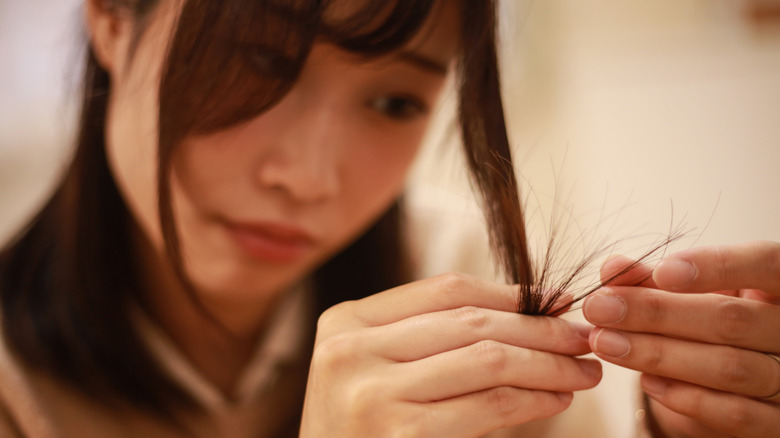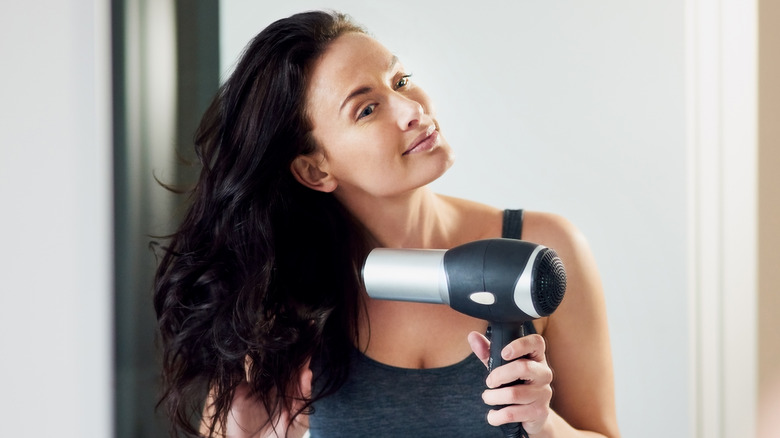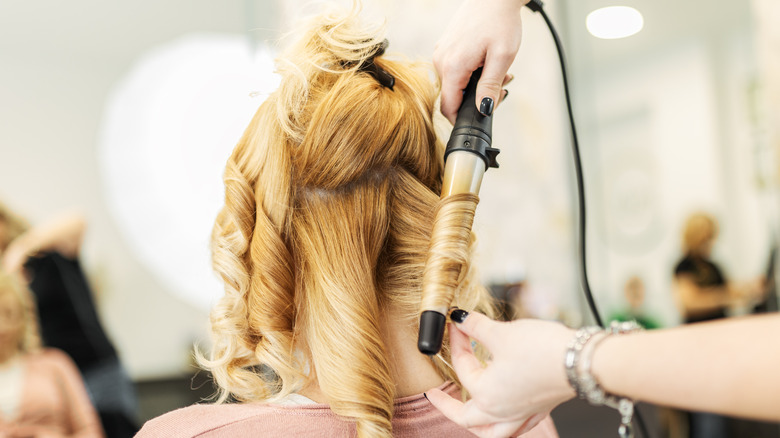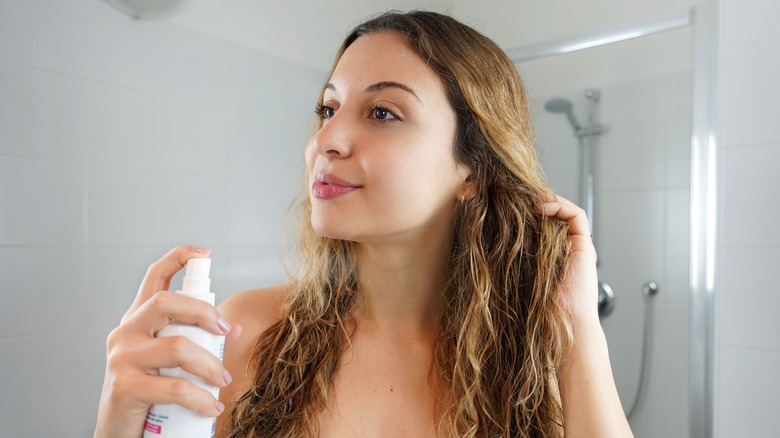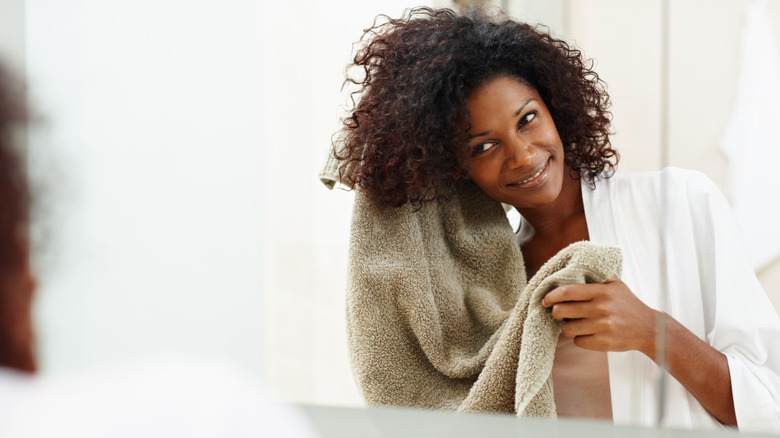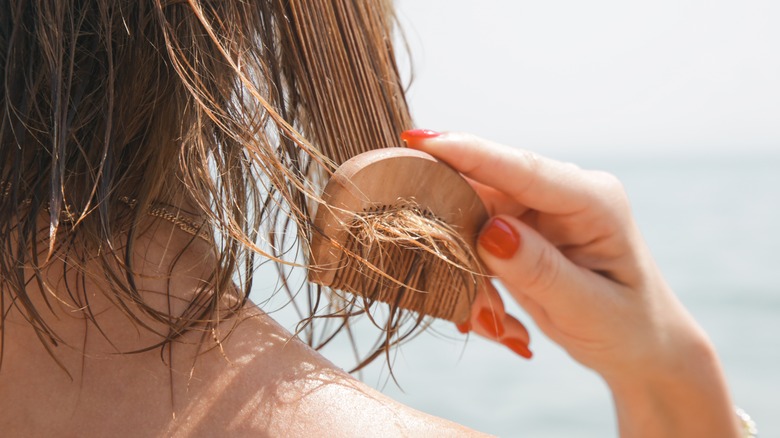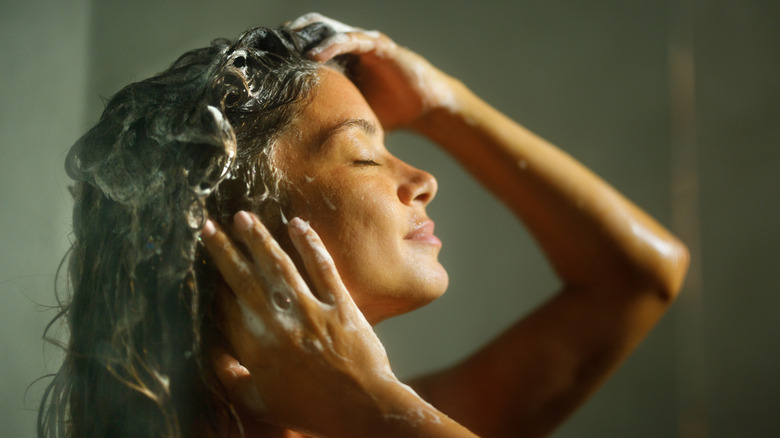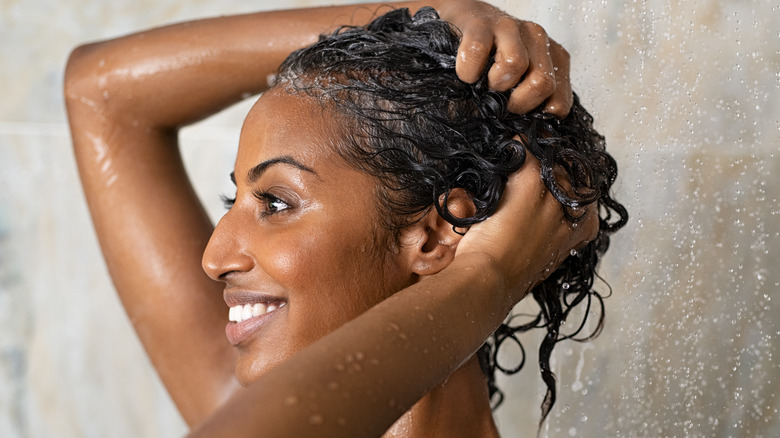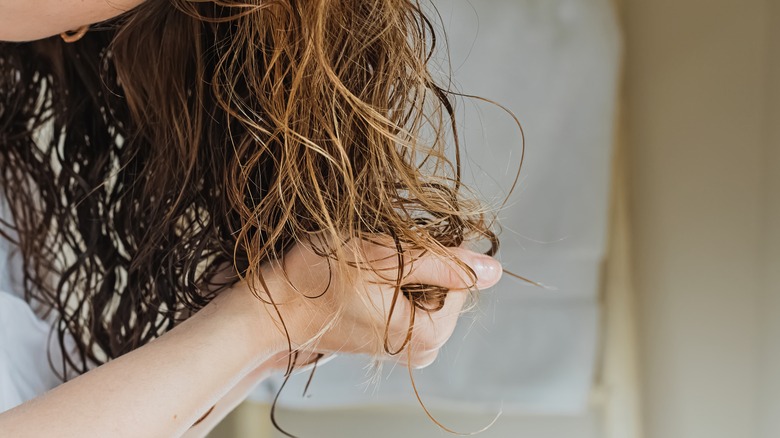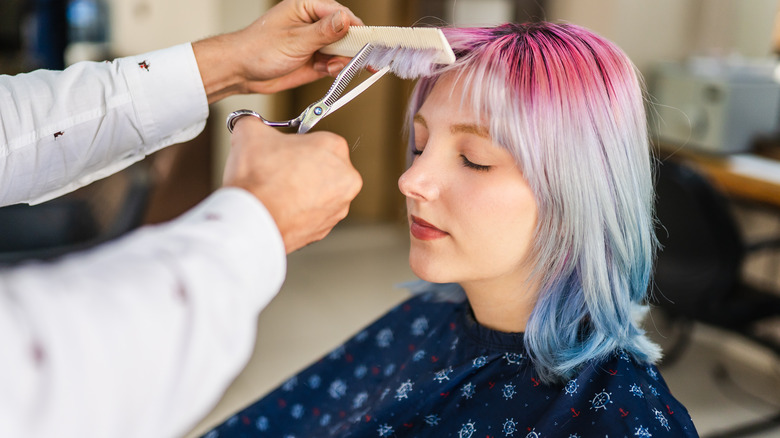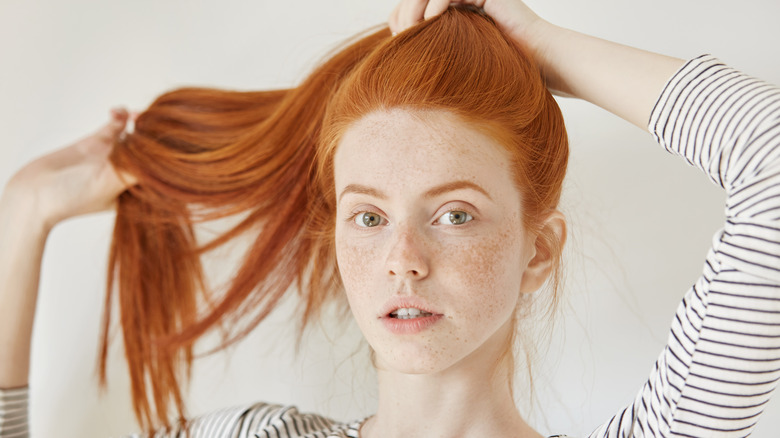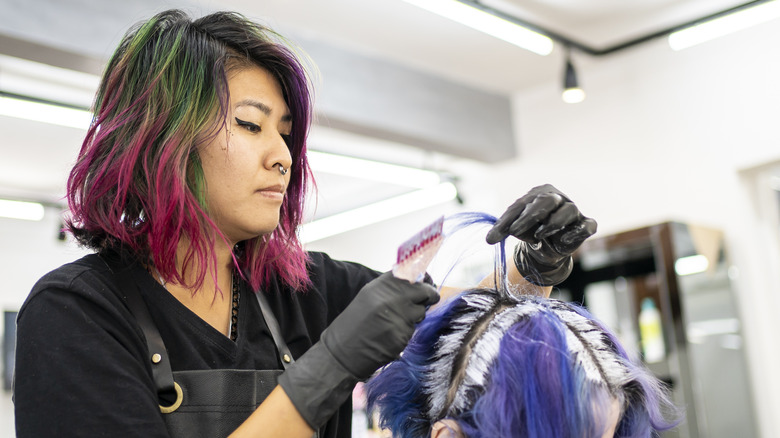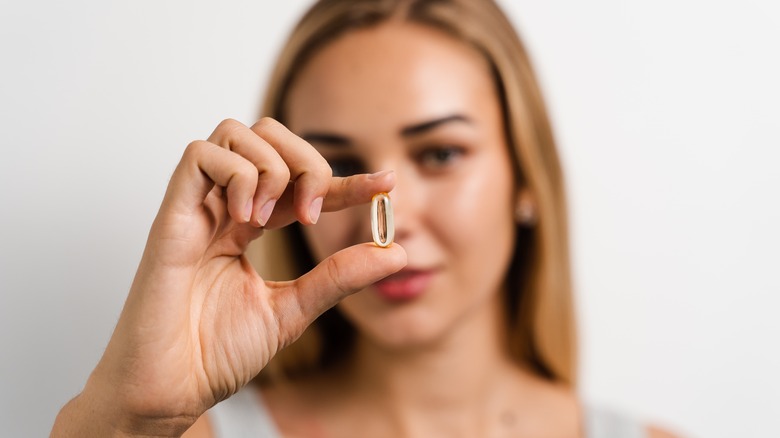Our Absolute Best Tips For Preventing Split Ends
Split ends (known as trichoptilosis or schizotrichia in the medical world) are one of those pesky hair annoyances that happen to the best of us. Splits usually form at the ends of the hair (hence the name) but can sometimes go all the way up the shaft too, forming when the hair's cuticles become damaged. In healthy hair, these cuticles lay flat, giving a smooth and shiny finish. In damaged hair, they don't. That's why hair containing split ends can look dull, limp, and lacking in elasticity.
There's not just one type of split end, either. There are a number of different ways hair can split. One of the least damaging versions is shaped like a small Y, which is what most of us think of when we imagine split ends. Then there are split ends shaped like a capital Y, in which a little more damage has been done.
There's also the fork split, which means your hair strand has divided into at least three different sections, and the tree split, which is when your hair strand has split so many times it literally resembles a tree. Because more cortical cells have been revealed with the last two types, it's harder to hide or temporarily seal these kinds of splits. But you don't have to be resigned to seeing split ends on your locks, because there are ways to prevent ever getting them.
Put the blow-dryer down
One of the main reasons split ends occur is because of damage caused by the regular use of super hot hair-styling tools. Particularly hairdryers, because they're usually your hair's first point of contact while it's still wet. "The overexposure to heat dries out the hair, making it brittle and prone to breakage," hairstylist Laura Polko admitted to InStyle. Therefore, allowing your hair to air dry rather than blasting it, even a couple of days a week, will do wonders for keeping those split ends at bay.
If you absolutely have to use a blow-dryer (don't worry, we get it) there are ways to use it more safely. Not keeping up with the latest technology can actually play a part in encouraging splits. A lot of research has been done on keeping hair healthy over the last few decades, which may mean the tool you've been using is causing more damage than it needs to. Polko recommends getting a blow-dryer with multiple heat settings so you can customize it to your hair.
"Using these things helps hair retain more moisture and therefore help your ends last longer," she shared. The hottest heat you should use? "I tell my clients not to go over 325 to 350 degrees at the most," celebrity hairstylist Mark Townsend said. Another tip? Try not to focus the blow-dryer on the ends of your hair, which are most susceptible to damage. Instead, make the roots the priority.
And avoid the hot hair tools too
Because so many hair tools, like straighteners and curlers, apply the heat directly to the hair, they too can be some of the worst offenders in encouraging split ends. So it goes without saying that cutting down on using heat tools is another way to keep your hair healthier and your splits at bay. Like using a blow-dryer, turning down the heat on your heat tools will go a long way in keeping the hair healthy.
"Overheating your hair with styling tools causes damaged areas and split ends. Try to use the low or medium setting when possible, and limit the use of hot tools on the vulnerable parts of your hair," hairstylist Arsen Gurgov told Byrdie. Equally, it's important you choose your tool wisely based on your hair type. If your hair is on the thinner side and holds curls well, it may not need such a severe curling tool set on high heat.
We also can't stress enough how imperative it is to put a heat protectant on your locks before getting too close with any kind of heat. Heat protectants come in a range of forms, from sprays to blow-dry lotions, and they'll create a barrier to stop the heat from penetrating the hair too deep. Therefore, your locks are less likely to suffer from cuticle damage.
Only apply appropriate products before styling your locks
When you are putting a heat tool on your hair, make sure it's as virgin as can be when it comes to hair products. That means only applying products you absolutely have to. In fact, we'd recommend trying to make your heat protectant the only thing on your locks before you style it with something hot. That means ditching things like hair oils or leave-in conditioners — at least until after you've worked on your tresses.
Though hair oils are great for adding some moisture to your strands, they're not so great when they come into contact with heat. "Most oils and heat don't work well together on hair," celebrity hairstylist Cash Lawless told Cosmopolitan. And a conditioner can be just as bad as an oil. "If, for example, you accidentally leave conditioner in your hair, or don't rinse it out all the way, you might be cooking your hair instead of styling it," he said. And it goes without saying that fried hair is a breeding ground for split ends.
Swap your normal towel for a microfiber towel
We know, we know — we've already advised you not to use a blow-dryer to help stop split ends in their tracks. So when it comes to drying your hair, the next best thing is towel drying it, right? Well, not necessarily. Because standard towels are made up of little loops that are designed to drag the moisture off our skin to keep us dry, they can actually end up doing more bad than good when it comes to our hair.
"They're so absorbent because your hair gets caught in between them and the cotton takes all the moisture out. The reason hair gets so matted and tangled is because all those tiny little loops rip open the hair cuticle," Mark Townsend told InStyle. And, as we already know, a lack of moisture is one of the main causes of hair splits.
That's why it's a good idea to ditch a regular towel and instead try a microfiber towel. This will help dry your locks without tugging on them. Hair stylist Arsen Gurgov, talking to Byrdie, recommended gently patting your hair with the microfiber towel to dry it off, as that will help prevent damage and tangles at the same time.
Stop brushing your hair while it's wet
Putting a standard brush on your tresses after washing them is one of the absolute worst things you can do. Though it may seem like you're helping to smooth out your tresses and get rid of any knots or tangles, in reality, your hair is way too sensitive during this time to be brushed. As VS Sassoon stylist Rob Reeves advised, "Whatever you do, do not brush your hair when it's wet because that's when it's at its weakest and becomes vulnerable to breakage (leading to flyaways), split ends and damage."
Instead, get yourself a product that's specifically designed to combat tangles in wet hair or, failing that, use a wide-tooth comb. Start the process by detangling your wet locks using a cream or serum, then run your hands through your hair to apply the product and gently break up any initial tangles. It's important you wait at least five minutes before taking your detangling tool or large comb to your hair. That way, you're less likely to snap or even stretch the hair while it's at its most vulnerable, which can cause split ends — or worse. Celebrity colorist and salon owner Michael Boychuck, talking to StyleCaster, suggested starting by combing the ends of your hair first, and then moving upwards to the root until it's all nice and smooth.
Cut down on how much you wash your hair
Though we may think that washing our hair is one of the best things we can do for it, it's definitely possible to overwash your locks, especially when it comes to shampoo. That's because too much shampoo can actually strip the hair of its natural oils, which work to keep our locks well moisturized (dryness is a big cause of split ends, remember). But how do you avoid using too much shampoo, especially if your hair needs regular washing?
"Pull your hair back into a ponytail and use the same amount of shampoo as the diameter of the ponytail," hairstylist Arsen Gurgov recommended to Byrdie. That way, you're less likely to contribute to dry hair, which should help to prevent split ends and other damage. After all, as Paul Labrecque, founder, creative director, and master stylist and colorist at Paul Labrecque Salon and Spa, pointed out to Best Health, "Once you create more dryness, you create more knots." Which could spell more split ends.
Not to mention, the more you wash your hair, the more you'll have to detangle, blow-dry, and, well, do pretty much everything else on our list to it. And that's going to make for some dry, weak, overprocessed locks. Though the sweet spot will be dependent on a number of personal factors like hair type and lifestyle, try washing your hair every two to three days instead of every day.
Using the right products to wash your hair is key, too
When you do wash your hair, it's vital you're using the right products. Celebrity hairstylist Linet K told Well + Good that if your hair is feeling weak and brittle, it could be a sign that you need a product that's more moisturizing in your life. A lot of dryness in the hair can actually result in frizzy locks, which can very easily result in split ends — particularly when you're trying to pull your brush through any tangles.
"The best advice I can give is to avoid getting split ends in the first place by treating your hair properly," Fabian Lliguin, co-founder of Rahua, said while speaking to Harper's Bazaar. "Protecting the ends of your hair is of utmost importance." To do that, Lliguin recommends reaching for a fortifying shampoo when you give your locks a wash. "[It] includes ingredients such as Rahua oil, quinoa, aloe, and green tea, to help hair grow stronger and, as a result, longer," they shared.
Don't forget the conditioner!
There's more to preventing split ends than just cutting down on washing your hair and using the right shampoo. Applying conditioner when you wash, particularly to the ends of your hair, will also contribute to healthier hair. That's because a conditioner is literally designed to hydrate the hair, and the more hydrated your locks are, the less likely the ends are to split.
"[Conditioners] coat wet hair so it's easier to detangle, which can lead to less damage and make it softer and more manageable," Good Housekeeping's Beauty Lab director Dr. Birnur Aral shared. Conditioner doesn't only have to be applied when washing your locks, though. A deep conditioner or regularly applied mask will also help moisturize dry hair and keep your tresses in good condition. The better condition your hair is in and the less dry it is, the less likely you are to get tangles and damage like split ends.
Just remember that nothing you can apply to your hair will actually re-seal a split end if you already have them. "Products like split end menders, leave-ins, conditioners and treatment masks can seal the outer layer of strands so they temporarily appear smoother and less frayed and feel softer," Dr. Aral shared, but they won't actually permanently fix them.
Regular trims will work wonders for preventing split ends
As we know, most people (especially those of us with long hair) will get split ends at some time in our lives. One way to ensure they're more of an anomaly than a regular occurrence is regular trims. "Little trims keep your hair shaft healthy and from continuing to split," hairstylist Matilde Campos told Allure. That's because, not only is a trim the only way to actually get rid of split ends once you have them, but cutting off the damaged, dead hair at the end will keep it much healthier. As stylist and salon owner Mackenzie Day explained to Best Health, "Trims are important because they cut split ends off so they don't climb up the hair and cause more split ends."
So, how often should you be getting a trim and how much should you get chopped off? Though everyone is different and hair length and style will play a big part in how often you should visit the salon, around six weeks is a good length of time to aim for between trims. When you're getting that trim, it's recommended you lose around a quarter of an inch to one inch of hair. This length is particularly useful if you already have split ends, as it's enough to stop the split from moving up the hair and is also enough to get to a healthier part of the strand above the split.
Try hair ties that won't damage the hair
Another reason split ends can form is due to the hair growing weak in parts. If you're a fan of going for the same hairstyle day after day and that style uses a hair tie, you may find your locks suffer from split ends and breakages where your hair tie regularly sits. As hairstylist Jenna Marie Shafer put it while speaking to Byrdie, "When you wear your hair in the same ponytail every day, you're adding stress to the same spot over and over and over again, and eventually that's going to cause your hair to snap and break off at the base of the ponytail."
To stop this, try one of our easy hairstyles that offer an alternative to damaging ponytails, to keep your hair out of your face without all the pressure on your hair. Or opt for hair ties that are specifically designed not to pull on the hair or put too much of a strain on certain parts if you really need a pony. That usually means hair ties that don't have any metal on them. "The metal pieces can snag and break your hair, causing split ends, broken pieces, and uneven strands," hairstylist Arsen Gurgov told Byrdie. Instead, opt for a spiral plastic hair tie or try alternatives like ribbons or a claw clip for easy hair styling.
There's a right way to get your hair colored, too
When it comes to preventing split ends, you may not be doing all you can if you're regularly coloring your hair. That's because putting dye on your locks can actually change its texture, often making it thinner and weaker. Not only that, but some dyes can really dry out the hair, which makes it far more susceptible to split ends. To keep your hair at its best, it's imperative you always get a hair cut at the same time as a color. "[This will] help maintain hair health and improve the texture of the hair," stylist Mackenzie Day told Best Health.
When it comes to dye, less is more when you're trying to prevent split ends. Bleaching is one of the worst offenders because the chemicals penetrate the hair cuticles, which can change the hair's structure. And weak or damaged cuticles are one of the fastest shortcuts to split ends. It's not just bleach, though. Permanent hair dyes also infiltrate the cuticles and can damage the locks because of the way they affect the inner layer of hair, while highlights can lead to splits because they contain ammonia, which doesn't lock in moisture. To help prevent split ends, it's a good idea to avoid hair dyes as much as you can. But if you're anything like us and you just can't stay away from the hair color, opting for a temporary dye will be less harsh on your tresses.
Try collagen supplements
Keeping split ends down is not just about how you interact with your hair. There are also ways to keep your hair healthier by focusing more on what you're putting into your body. One of the best ingredients you can swallow for strong and thriving hair? Collagen supplements. Yep, collagen's not only for skincare anymore! In fact, hair with a lot of split ends that looks dull and dry can actually be a sign that your body's collagen levels are low. Low collagen levels can then lead to fragile hair, which, in turn, results in split ends.
"With age, your hair loses its elasticity, leading to hair breakage. Collagen will improve the strength and hydration of your hair," Michele Antiga, colourist and stylist, told Glamour. As for how long it will take for you to see the effects? Antiga said you should start seeing a difference in the four to six-week mark, but it could take up to 12 weeks for you to see optimal results.
